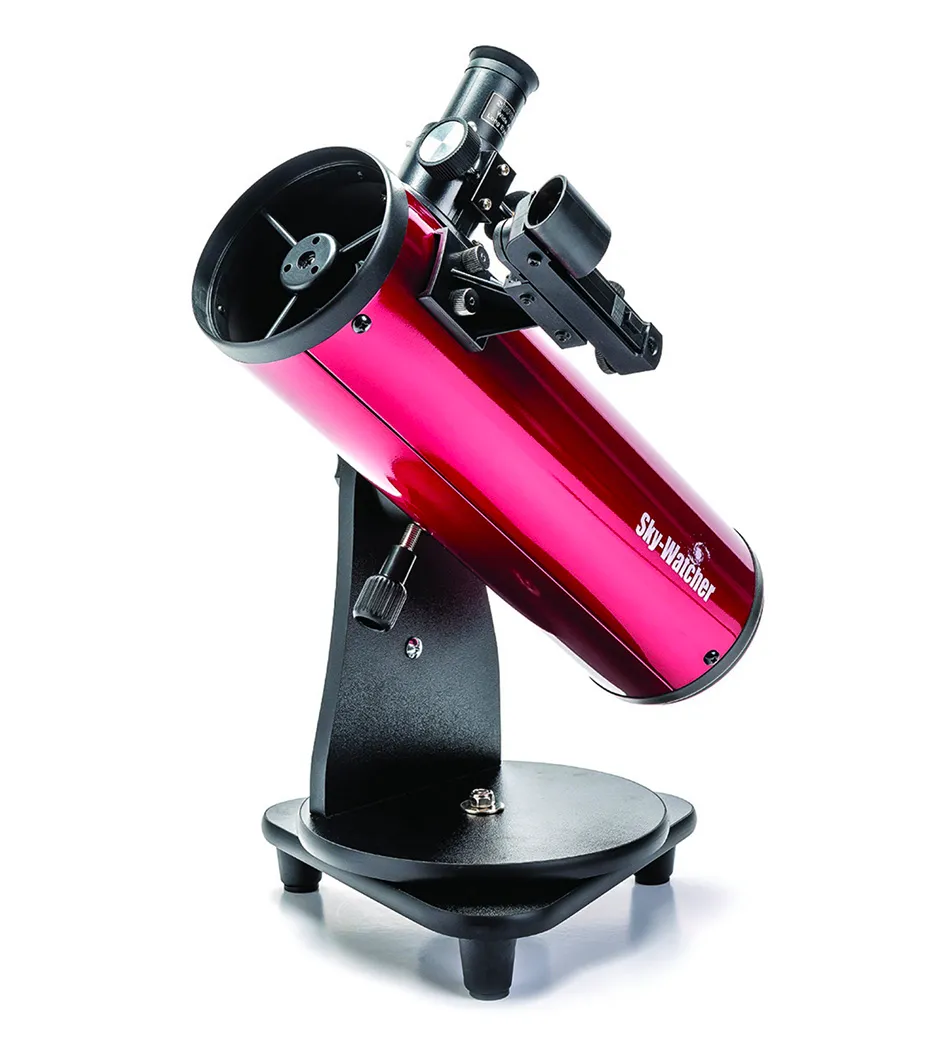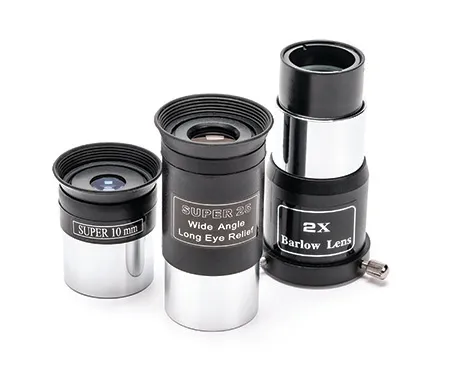The Heritage 100P is a 4-inch tabletop Dobsonian from Sky-Watcher that costs just under £100.The Heritage 100P looks stylish. Its 4-inch parabolic mirror has a focal length of 400mm, giving a focal ratio of just f/4.
It comes packaged with two 1.25-inch eyepieces (25mm and 10mm), a 2x Barlow lens and a red-dot finder.
Installation is easy: attach the finder, pop in an eyepiece, and you can be viewing the heavens in moments.
As the name suggests, the Heritage 100P Tabletop is a telescope that’s been designed to sit on top of something else – a garden table or any other flat, medium-height surface will suffice.
Indeed, we could sit down in comfort and view most of the sky when we used it on the patio table.
This telescope features in our lists of the best telescopes for beginners and best telescopes for kids. For more models like this, read our guide to the best tabletop telescopes.

The focuser is a basic rack and pinion type; it was a little stiff, but still gave good control.
The finder is zero magnification, with its small red dot projected onto a clear screen, and we found it very easy to align with the main telescope.
One quibble with the focuser and finder is that their positioning feels wrong when it comes to using the telescope.
We found the finder sometimes seemed to be in the way when we looked through the eyepiece; if their positions on the tube were swapped, it would improve the ease of use.
The mount gave good support and was smooth to use.

Accommodating field of view
To check the quality of the optics, we first aimed the Heritage 100P at Regulus in Leo.
Through the 25mm eyepiece the star remained a pin point for the central 60 per cent of the view, but beyond that it quickly deteriorated and showed signs of coma.
Overall, the wide field views were not too bad; a fact confirmed when we turned to the galaxy pair of M81 and M82 in the Ursa Major.
Swapping in the 10mm eyepiece gave us a better view of M82’s edge-on aspect, we could even make out some mottled structure along it.
Elsewhere in the sky, we had to look at M13, the northern hemisphere’s showcase globular: the wide-field view offered by the 25mm eyepiece was pleasant, but the increased magnification offered by the 10mm eyepiece plus Barlow lens allowed us to see a sprinkling of stars.
Binary star Albireo showed wonderfully contrasting colours, especially through the 10mm eyepiece.
We then turned to the major bodies of the Solar System. Jupiter was small even with the 10mm eyepiece, but we could see the equatorial bands and the four Galilean moons.
Mars surprised us: the Dobsonian revealed a polar cap and dusky markings on the planet’s small disc.
Saturn and its rings were a delight, with Titan and Rhea also visible and we were able to see plenty of craters on our Moon, although not in great detail.
The Heritage 100P is a small, simple scope but it can provide rewarding views as long as you have realistic expectations.
No fuss exploring
If a telescope proves too difficult to set up or use then there’s every chance that it will fall into disuse – it may even put its owner off exploring the night sky.So, by being compact, lightweight (2.8kg) and quick to put into action, the Heritage 100P could easily help to kickstart a lifelong interest in the Universe around us.
Despite its small size it still gave decent views of a range of celestial wonders.We found it was easy to store and bring out quickly whenever the clouds cleared.
Moreover, the Heritage 100P’s simple design allows it to be placed on a patio table or similar flat surface for that quick view, making it ideal to show off the brightest night-sky objects at social events.
It would also make an ideal first telescope for a budding young astronomer.
Finder
A red-dot finder is a reasonable choice for a telescope of this size as it is simple to use and quite lightweight.However, it felt as if it was in the way when using the focuser, and when the telescope was pointed vertically it was not easy to look up through the finder.
Eyepieces
Two basic eyepieces are packaged with the Heritage 100P, one 25mm giving 16x magnification, the other 10mm giving 40x magnification.The 25mm eyepiece was adequate but did not provide a sharp view across the whole field, but its 10mm counterpart gave pleasing views. A 2x Barlow lens is also supplied.
Mount
The wooden, single arm altaz mount gave good free movement in azimuth.Altitude axis movement is smooth in use, and tension can be adjusted by a chunky knob at the side.The telescope is attached to the mount with a Vixen-style bar and can be removed if needed.
Focuser
The focuser is a basic rack and pinion style and takes 1.25-inch eyepieces.It was a little stiff but reasonably smooth to use.The focuser’s position on the telescope body did seem a little awkward and would have been better swapped with the position of the finder.
Optics
The 4-inch parabolic mirror has a relatively fast focal length of 400mm, giving the system a focal ratio of f/4.The optics performed reasonably well for their size and provided pleasing views of lunar, planetary and brighter deep-sky targets.
Where to buy
Vital stats
- Price £99.00
- Aperture 100mm (4-inch)
- Focal Length 400mm (f/4)
- Mount Wooden altaz
- Weight 2.8kg
- Supplier Optical Vision
- Telephone 01359 244200
- Websitewww.opticalvision.co.uk
This review originally appeared in the August 2014 issue of BBC Sky at Night Magazine.